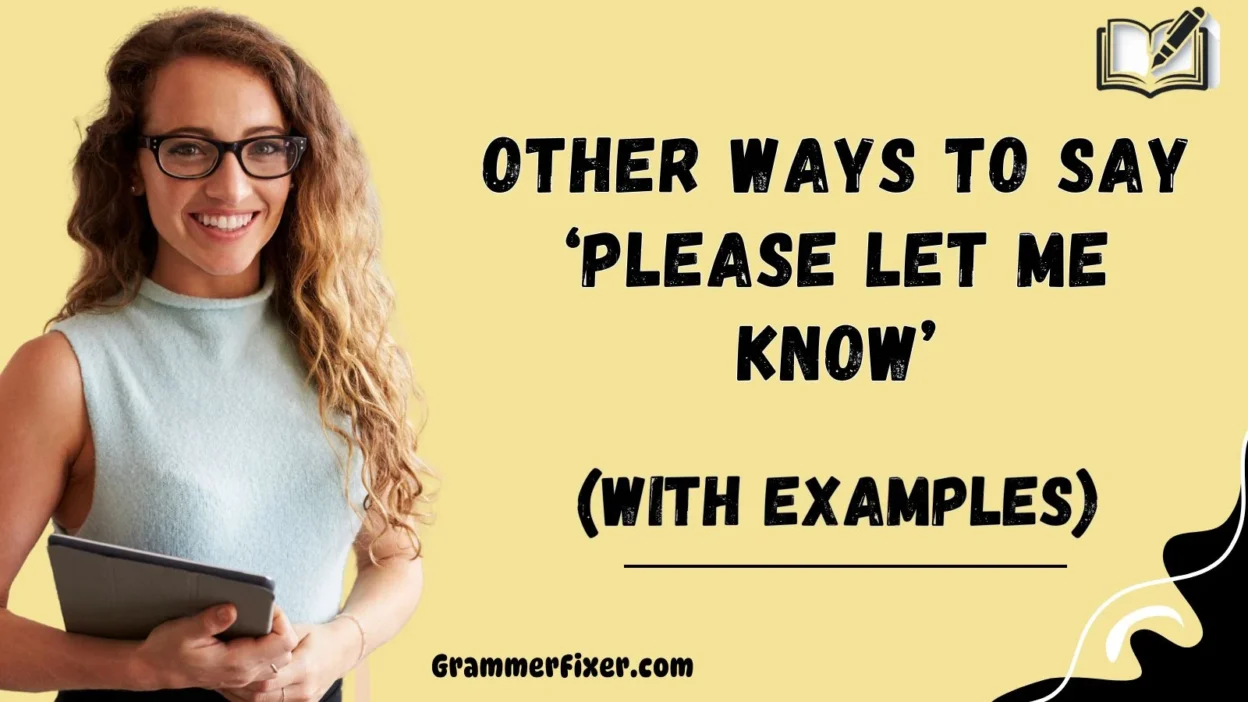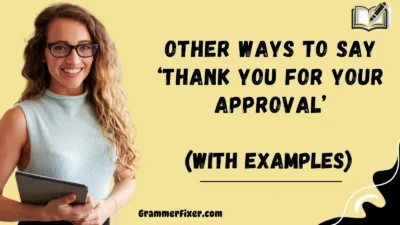Finding the right words to express care, attention, and professionalism can completely transform the way your message is received. Whether you’re writing to a colleague, client, or team member, the phrase “Please let me know” can sometimes sound too standard or overused. By choosing alternative phrases that show warmth, attentiveness, and genuine interest, you can make your communication feel more personal, professional, and memorable.
In this article, we’ll explore 30 thoughtful alternatives to say “please let me know” — each with examples, tone suggestions, and explanations to help you pick the perfect one for any situation.
What Does “Please Let Me Know” Mean?
The phrase “Please let me know” is a polite request for information, confirmation, or feedback. It expresses that you are open to hearing from someone and value their response or input. It’s often used to encourage communication and clarity in both formal and informal exchanges.
When to Use “Please Let Me Know”?
Use “please let me know” when you’re:
- Asking for updates or confirmation
- Requesting someone’s opinion or decision
- Following up on a discussion or project
- Showing openness to continued communication
It’s suitable for emails, business messages, and even casual texts, as long as the tone remains polite and considerate.
Is It Professional/Polite to Say “Please Let Me Know”?
Yes — it’s both professional and polite. The phrase shows respect for the other person’s time and input while keeping the tone soft and approachable. However, when overused, it can feel generic or impersonal, which is why alternatives can help you sound more genuine and specific.
Pros or Cons
Pros:
- Polite and universally accepted
- Easy to understand
- Works in both formal and casual settings
Cons:
- Can sound repetitive or robotic
- Lacks emotional warmth if overused
- May not express urgency or sincerity clearly
1. Kindly Keep Me Updated
Meaning: A polite way to request ongoing updates or progress information.
Detailed Explanation: This phrase sounds courteous and formal, making it perfect for business communication.
Example: “Kindly keep me updated on the project timeline.”
Best Use: Client communication or professional check-ins.
Worst Use: In casual chats—it may sound too stiff.
Why It Works: It conveys respect and professionalism.
Tone: Formal, polite, and attentive.
2. I’d Appreciate Your Update
Meaning: A gentle way to show gratitude in advance for their response.
Detailed Explanation: This phrase subtly adds appreciation, which makes it warmer.
Example: “I’d appreciate your update when convenient.”
Best Use: When you’re waiting for a report or feedback.
Worst Use: When you need immediate answers.
Why It Works: Gratitude softens the request.
Tone: Polite and appreciative.
3. Please Keep Me Posted
Meaning: A friendly and approachable way to stay informed.
Detailed Explanation: Often used in professional and conversational contexts alike.
Example: “Please keep me posted about any schedule changes.”
Best Use: Ongoing projects or event coordination.
Worst Use: Formal proposals—it may sound casual.
Why It Works: Feels natural and conversational.
Tone: Warm, casual-professional.
4. Let Me Know How Things Progress
Meaning: A considerate request for updates as situations evolve.
Detailed Explanation: Implies interest and engagement.
Example: “Let me know how things progress after your meeting.”
Best Use: When you want follow-up insight.
Worst Use: For quick decisions or yes/no responses.
Why It Works: Shows empathy and curiosity.
Tone: Supportive and engaging.
5. I’d Love to Hear Your Thoughts
Meaning: Invites feedback warmly and personally.
Detailed Explanation: Creates a friendly, open tone.
Example: “I’d love to hear your thoughts on the new proposal.”
Best Use: Brainstorming or collaborative discussions.
Worst Use: When formal updates are needed.
Why It Works: Encourages honest dialogue.
Tone: Warm, personal, and inclusive.
6. Please Share Your Feedback
Meaning: A direct but polite invitation for feedback.
Detailed Explanation: Keeps the focus on improvement and collaboration.
Example: “Please share your feedback on the design draft.”
Best Use: Professional reviews or team discussions.
Worst Use: In emotional or informal messages.
Why It Works: Clear, actionable, and professional.
Tone: Polite and constructive.
7. Could You Kindly Inform Me
Meaning: A formal and respectful way to ask for information.
Detailed Explanation: Often used in corporate or official communication.
Example: “Could you kindly inform me of the next steps?”
Best Use: When addressing higher authorities or clients.
Worst Use: Casual chats—it sounds overly formal.
Why It Works: Politeness enhances respect.
Tone: Formal and deferential.
8. Keep Me in the Loop
Meaning: A common expression meaning “keep me informed.”
Detailed Explanation: Ideal for teamwork and collaboration.
Example: “Please keep me in the loop on any new updates.”
Best Use: Internal communication.
Worst Use: Formal external messages.
Why It Works: Sounds cooperative and friendly.
Tone: Informal, engaging, and modern.
9. I’d Be Grateful for an Update
Meaning: Expresses gratitude and humility in your request.
Detailed Explanation: Best when you’re requesting something important.
Example: “I’d be grateful for an update on your review.”
Best Use: Professional or formal emails.
Worst Use: In short or casual messages.
Why It Works: Gratitude fosters goodwill.
Tone: Polite, respectful, and sincere.
10. Let Me Know What You Think
Meaning: A conversational way to ask for opinions.
Detailed Explanation: Encourages two-way communication.
Example: “Let me know what you think about the presentation.”
Best Use: Collaborative work or brainstorming.
Worst Use: Highly formal situations.
Why It Works: Feels personal and inclusive.
Tone: Friendly and open.
11. Please Confirm When Possible
Meaning: A polite way to request confirmation or acknowledgment without sounding pushy.
Detailed Explanation: This phrase respects the other person’s time while still signaling the need for a response. It’s courteous yet clear.
Example: “Please confirm when possible if the schedule works for you.”
Best Use: Scheduling meetings, confirming attendance, or validating details.
Worst Use: When urgency is required; it may sound too relaxed.
Why It Works: Balances politeness with professionalism.
Tone: Courteous and neutral.
12. I’d Appreciate Your Response
Meaning: Expresses gratitude for a reply in advance, adding warmth to the request.
Detailed Explanation: This is a slightly softer version of “please respond,” which makes it feel less demanding.
Example: “I’d appreciate your response regarding the updated proposal.”
Best Use: When waiting for important feedback or decisions.
Worst Use: Informal or brief messages—it might feel overly formal.
Why It Works: It frames the request with appreciation and respect.
Tone: Polite, appreciative, and professional.
13. Keep Me Updated When You Can
Meaning: A flexible, kind request for updates without imposing pressure.
Detailed Explanation: Perfect when you want to stay informed but acknowledge the other person’s schedule.
Example: “Keep me updated when you can about the final edits.”
Best Use: Ongoing projects or team collaboration.
Worst Use: Formal client communication—it may sound too casual.
Why It Works: Demonstrates patience and understanding.
Tone: Gentle and relaxed.
14. Please Notify Me
Meaning: A straightforward way to request to be informed about specific developments.
Detailed Explanation: Common in business or operational communication where clarity is crucial.
Example: “Please notify me once the shipment has been dispatched.”
Best Use: Logistics, operations, or official updates.
Worst Use: Creative or collaborative discussions—it sounds too mechanical.
Why It Works: It’s direct and unambiguous.
Tone: Formal and efficient.
15. Do Let Me Know
Meaning: A friendly and conversational variant of “please let me know.”
Detailed Explanation: It keeps the tone approachable and slightly informal while maintaining respect.
Example: “Do let me know if you’re free for a call tomorrow.”
Best Use: Colleagues, partners, or friendly professional contexts.
Worst Use: Corporate or hierarchical messages—it can sound too relaxed.
Why It Works: Adds a human touch to professional exchanges.
Tone: Warm, conversational, and polite.
16. I’d Love Your Input
Meaning: Invites ideas and feedback in an encouraging way.
Detailed Explanation: This phrase makes people feel valued and involved, fostering collaboration.
Example: “I’d love your input on how we can make this campaign more engaging.”
Best Use: Team discussions or brainstorming sessions.
Worst Use: Requests for factual updates—it’s meant for opinions.
Why It Works: Promotes inclusivity and appreciation.
Tone: Friendly, collaborative, and engaging.
17. I’d Appreciate Your Thoughts
Meaning: A sincere way to seek opinions while showing respect for the recipient’s perspective.
Detailed Explanation: Works well when you want constructive feedback or deeper insight.
Example: “I’d appreciate your thoughts on the revised design.”
Best Use: When seeking feedback from colleagues or mentors.
Worst Use: For brief transactional communication.
Why It Works: Feels thoughtful and considerate.
Tone: Warm, polite, and reflective.
18. Please Reach Out When Convenient
Meaning: Suggests open communication while showing sensitivity to the other person’s time.
Detailed Explanation: This phrase gives flexibility, removing any sense of urgency or demand.
Example: “Please reach out when convenient to discuss the next steps.”
Best Use: Follow-up or casual reminders.
Worst Use: Urgent updates—it can imply no rush.
Why It Works: Sounds professional and courteous.
Tone: Respectful, flexible, and professional.
19. I’d Be Happy to Hear Back
Meaning: Expresses eagerness for a response in a positive, lighthearted way.
Detailed Explanation: Great for keeping the tone warm and approachable.
Example: “I’d be happy to hear back once you’ve reviewed the document.”
Best Use: Client relations, friendly follow-ups.
Worst Use: Very formal communication.
Why It Works: Encourages response with kindness.
Tone: Warm, open, and optimistic.
20. Please Advise
Meaning: A formal way to ask for guidance or direction.
Detailed Explanation: Commonly used in professional emails seeking clarification or next steps.
Example: “Please advise on how to proceed with the application.”
Best Use: Corporate, administrative, or policy-related exchanges.
Worst Use: Friendly or informal emails—it may sound too stiff.
Why It Works: Communicates respect for authority or expertise.
Tone: Formal, respectful, and direct.
21. Share Your Opinion When You Have a Moment
Meaning: A polite way to invite feedback without rushing someone.
Detailed Explanation: It gives them room to respond at their convenience, making the tone easygoing.
Example: “Share your opinion when you have a moment about the new concept.”
Best Use: Brainstorming or collaboration contexts.
Worst Use: Time-sensitive updates.
Why It Works: Balances openness with patience.
Tone: Relaxed, kind, and collaborative.
22. I’d Appreciate Any Update
Meaning: A gentle reminder that signals you’re waiting for information.
Detailed Explanation: Perfect for follow-ups where you need progress but don’t want to seem impatient.
Example: “I’d appreciate any update on the report’s status.”
Best Use: After a reasonable waiting period.
Worst Use: For brand-new requests—it could sound impatient.
Why It Works: Shows patience and politeness simultaneously.
Tone: Soft and professional.
23. Keep Me Advised
Meaning: A concise way to request ongoing updates in formal settings.
Detailed Explanation: Commonly used in business or legal communication.
Example: “Please keep me advised on any contractual changes.”
Best Use: Legal, business, or project oversight contexts.
Worst Use: Casual communication—it sounds corporate.
Why It Works: Conveys authority and attentiveness.
Tone: Formal and serious.
24. Please Let Me In On Any Changes
Meaning: A more friendly and conversational way to ask for updates.
Detailed Explanation: Suggests inclusion and trust.
Example: “Please let me in on any changes before the next meeting.”
Best Use: Internal team communication.
Worst Use: With clients—it’s too casual.
Why It Works: Builds rapport and approachability.
Tone: Friendly and cooperative.
25. Do Keep Me Posted
Meaning: An inviting and semi-formal way to stay informed.
Detailed Explanation: Similar to “keep me updated,” but slightly warmer.
Example: “Do keep me posted about the final draft.”
Best Use: Colleague or peer updates.
Worst Use: Formal letters or reports.
Why It Works: Maintains politeness with approachability.
Tone: Polite and conversational.
26. I’d Value Your Feedback
Meaning: Communicates deep respect for someone’s opinion.
Detailed Explanation: Perfect for when you genuinely value the other person’s expertise.
Example: “I’d value your feedback on the marketing proposal.”
Best Use: Requesting professional input.
Worst Use: For routine updates—it’s too weighty.
Why It Works: Builds trust and mutual respect.
Tone: Respectful, thoughtful, and warm.
27. Feel Free to Update Me Anytime
Meaning: Signals openness and ongoing communication.
Detailed Explanation: Removes barriers and invites contact.
Example: “Feel free to update me anytime about the client’s response.”
Best Use: With colleagues or team members.
Worst Use: In formal requests—it may sound too casual.
Why It Works: Encourages collaboration and comfort.
Tone: Casual, friendly, and positive.
28. I’d Appreciate Hearing From You
Meaning: A formal yet friendly request for a response.
Detailed Explanation: Works well in follow-ups or polite reminders.
Example: “I’d appreciate hearing from you once you’ve had a chance to review.”
Best Use: Client or partner communication.
Worst Use: Informal exchanges.
Why It Works: Communicates interest without pressure.
Tone: Polite, patient, and considerate.
29. Please Respond at Your Earliest Convenience
Meaning: A courteous way to request a timely reply.
Detailed Explanation: Balances professionalism with respect for the recipient’s schedule.
Example: “Please respond at your earliest convenience regarding the agreement.”
Best Use: Time-sensitive yet polite requests.
Worst Use: For urgent issues—it can sound too soft.
Why It Works: Encourages promptness with politeness.
Tone: Formal and considerate.
30. Let’s Stay in Touch on This
Meaning: A friendly and forward-looking way to express continued communication.
Detailed Explanation: Suggests collaboration and ongoing involvement.
Example: “Let’s stay in touch on this as things move forward.”
Best Use: Projects requiring ongoing coordination.
Worst Use: When a one-time reply is enough.
Why It Works: Keeps communication lines open and warm.
Tone: Friendly, positive, and team-oriented.
Conclusion
Finding alternatives to “please let me know” allows you to communicate with more warmth, intention, and clarity. Each variation carries a slightly different emotional tone — from formal and respectful to friendly and collaborative. Choosing the right phrasing helps you align your tone with your relationship and purpose, showing that you value the other person’s time, thoughts, and effort.
In professional communication, words aren’t just about getting information — they’re about building understanding, empathy, and connection. So next time, instead of a simple “please let me know,” try one of these alternatives to make your message feel more personal, thoughtful, and genuinely professional.



